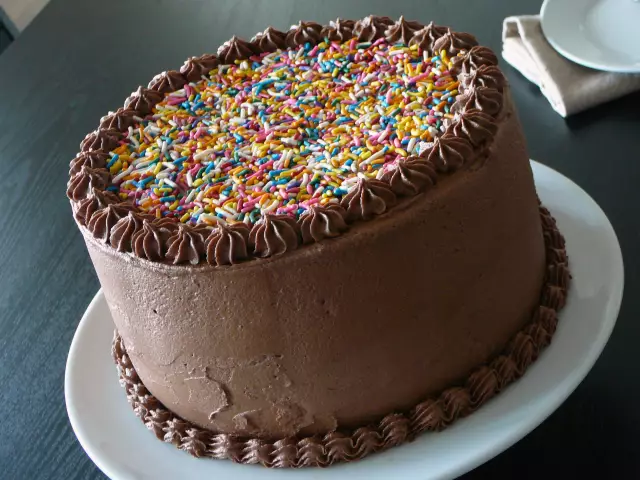- Author Rachel Wainwright [email protected].
- Public 2023-12-15 07:39.
- Last modified 2025-11-02 20:14.
Icing

Icing is a sugar-protein drawing paste used for decorating cakes and other confectionery. It can be white or colored if you add special dyes.
Icing recipes
There are several recipes for icing, but most often confectioners use the following options for its preparation:
"Royal Icing".
Ingredients:
- 250 g icing sugar;
- 0.5 tsp lemon juice;
- 1 egg white.
To prepare icing, sift the powder, and carefully separate the protein from the yolk and beat with a fork until a light foam is obtained. Stirring the mass continuously, pour in the icing sugar in a thin stream and beat until a stable mixture is formed. Lemon juice is added at the very end, because if you pour it in earlier, the products are more fragile.
Albumin icing recipe.
The difference between this cooking method and the previous one is that instead of raw egg white, dry - albumin is used, but the whipping time of the mixture increases somewhat (from 3-4 minutes when working with raw protein to 6-7 minutes with albumin).
Meering Powder icing recipe.
Ingredients:
- 450 g icing sugar;
- 3 tbsp powder "Mehring powder";
- 6 tbsp warm water.
The mixture is whipped with a mixer at low speed for 7-10 minutes. Its consistency is regulated by water. You can buy protein powder in specialized stores.
After preparing the drawing mass, it can be painted with watery or helium paints, and to prevent icing from spreading, you need to add a little powdered sugar to it.
Flexible icing
The art of confectionery decoration has reached a new level with the advent of flexible icing. Prior to that, sugar decorations required very careful handling, and working with them was long and meticulous. Such products dried out for a long time, broke easily, and to give the decorative elements the desired shape, they had to dry on uneven surfaces. Flexible icing (Sugarveil) solved most of these problems.
The main advantages of the mixture from Sugawail are:
- Mixing for a few minutes with the correct amount of water added;
- Drawings freeze in half an hour, and from an ordinary mixture in about 12 hours;
- Decoration elements are easily separated from parchment or polyethylene, while they are elastic and do not break even if the pattern is very thin;
- The flat pattern easily takes the shape of the surface on which it was placed, that is, the lace can be glued to the bend of the cake or to its side;
- Flexible icing jewelry can be applied to the product just before serving.
It is extremely difficult to draw laces from Sugawail by hand, so it is better to use silicone molds with ready-made designs. The solution is poured into a stencil, and then leveled, after which it can be easily removed.
It is possible to work with silicone molds only with a mixture of Sugawail, since, when hardened, it forms an elastic structure that can be easily removed. Drawings from the usual mass are likely to break with such manipulations. Flexible laces can be used as a full ribbon, or individual decorative elements can be cut out of them.
How to work with icing
The icing technique for decorating cakes is one of the most ancient, sophisticated and expensive. Currently, there are more than 10 methods for decorating confectionery with sugar-protein mass, but the principle of working with icing remains unchanged.
To prepare a decoration, you need to sketch the product or take a stencil. Then a piece of cellophane is placed on the selected template so that the outlines of the drawing are clearly visible.
After that, a cone-shaped bag with a hole at the base is rolled up from thick paper, which is filled with drawing mass. Then, carefully squeezing the icing out of the cone, it is necessary to circle the pattern on the stencil, applying the mass to the cellophane. The resulting sketch is left to dry.
Since icing products for cake decorating are very fragile, a little more blanks should be made than necessary. In order to give some form to the decorative elements, you need to prepare devices of the appropriate shape. For example, painted butterflies are dried on a slightly open book. In this case, they turn out to be not flat, but with raised wings.
To obtain openwork spherical products, the protein mass should be applied to small inflated balloons lubricated with vegetable oil. After the icing dries, the balls are pierced and carefully removed from the resulting jewelry.

Individual parts can be glued together with egg white, previously mixed with powdered sugar.
Depending on the size of the part and the humidity of the air, the drying time of the products also differs. An ordinary flower dries for two days, and huge elements take up to 5-6 days. The workpieces can be put in the oven, but the temperature in it should not exceed 40 ° C.
Iceing cake decorations can be placed on the surface of finished (baked and cooled) sufficiently dry confectionery products, on chocolate and other sweets that do not require special storage conditions.
Finished decorative blanks can be stored in a box for a long time at room temperature and normal humidity. In no case should you put icing decorations in the refrigerator, since they liquefy under the influence of the cold, therefore, pre-prepared products are placed on the cake immediately before serving.
Found a mistake in the text? Select it and press Ctrl + Enter.


